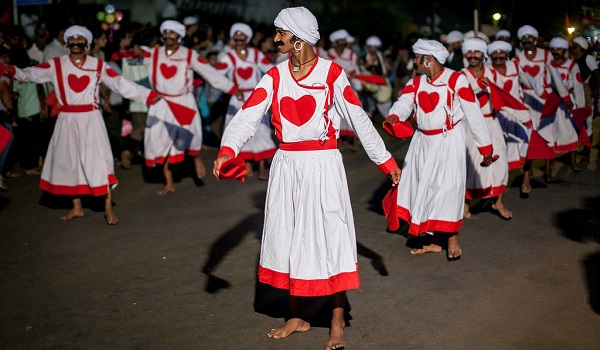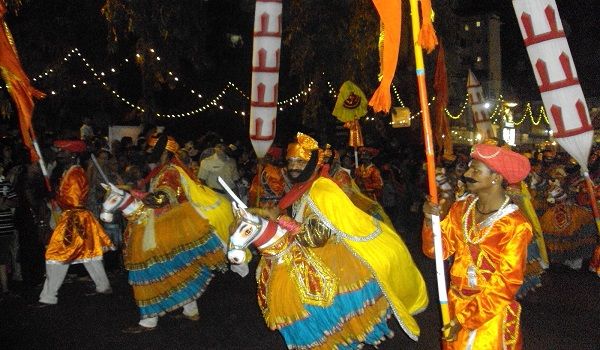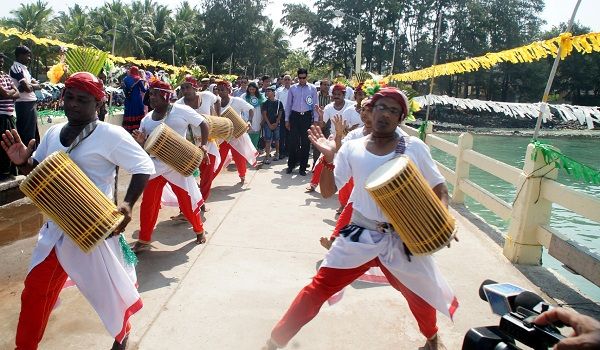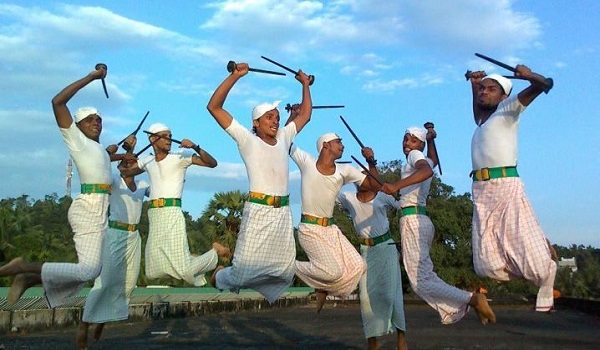Since the South West region of India was largely influenced by the West Asian countries and some European nations like Portugal, everything ranging from cuisine to culture has had its share of impact. Folk dances though have been largely untouched as their origin predates the invasion of these countries. Hence, getting to know about these dances becomes utmost important as they narrate the story of aboriginals, in the most artistic way possible.
Fugdi

Image Source: Goanewswire.files.wordpress.com
Region/Area: Goa/ Konkan
Occasion: Performed during festivals like Ganesh Chaturthi or while undertaking a religious vow
Highlight: Women make a peculiar sound while dancing
Fugdi dance is performed in the Konkan region of Goa. It is an unusual art form as it was contrived so that women can take a break from their daily routine. Usually performed in August and September, Fudgi involves women dancers forming circles or rows. The dance begins at a slow pace and gains momentum gradually. Singing is done by the dancers themselves with no musical accompaniment. The only music that supports the performance is a peculiar sound made by the women before the dancing comes to an end.
Dhalo

Image Source: http://artandculture.goa.gov.in
Region/Area: Goa
Occasion: Performed by women while praying for the well-being of their family members, especially their husbands
Highlight: On the final day of the performance, women draw pictures of men
Dhalo is a popular folk dance from Goa. It is performed in the month of Pousha (month in the Hindu calendar) just before the arrival of winter. This dance form serves as a prayer as women perform it hoping that it would bring happiness and good health to their family members, especially their husbands. It is usually performed by a group of 12 to 24 women who form two parallel rows, with women of one row facing the other. The dancers place their arms on the waist of the adjacent dancer and start swaying gently to the tune of the songs sung. The performance is repeated for about a period of one week and ends with women drawing pictures of men on the last day.
Dhangar Dance

Image Source: itsgoa.com
Region/Area: Goa
Occasion: Performed during the Navratri festival
Highlight: The dancers wear a unique white-colored long robe and a turban
Also known as the ‘Dhangari Gaja Dance’, Dhangar is performed by the shepherd community of Goa. During the tenth day of Navratri festival, all the dancers assemble in a place and dance with vigor in order to seek the blessings of their local deity. The dance is supported by musical instruments like ‘Dhol’, an elongated flute known as ‘Pawa’ and cymbals. The songs sung during the performance narrate the love stories of Radha and Krishna.
Ghodemodni

Image Source: http://goanz-snapworld.blogspot.in
Region/Area: Goa
Occasion: Performed to celebrate the victory of the Maratha warriors over the Portuguese
Highlight: Dance takes the form of a horse ride
Ghodemodni is a popular folk dance of Goa. Performed to celebrate the victory of the Maratha warriors over the Portuguese, Ghodemodni is basically a war dance. Dancers mount a fake horse, wield a sword and go about dancing to the music made from instruments like ‘Dhol’ and cymbals. Since it celebrates the victory of the Maratha warriors over the Portuguese, the dancers wear costumes that represent a Rajput chieftain and headgears sported by the Maratha rulers.
Tarangmel
Region/Area: Goa
Occasion: Performed during Dussehra and Holi celebrations
Highlight: Young boys and girls wear colorful costumes and invite their fellow citizens to join the celebrations
Tarangmel is an energetic and youthful dance of Goa. The Tarangmel dance is usually performed during Dussehra and Holi celebrations. Young girls and boys throng the streets in colorful attire, waving flags and streamers (tarang). This gathering of young people is an invitation for everyone else to join in the festive spirit. The musical instruments used during Tarangmel are 'Romut', 'Dhol' and 'Tasha'.
Goff

Image Source: http://dancefoms.blogspot.in
Region/Area: Goa
Occasion: Performed at the Shigmo festival
Highlight: Different types of braids are skillfully woven during the performance
In this unique folk dance, men hold on to a cord each that are suspended from above and go about dancing in circle according to the rhythm of the song. In the process, they end up weaving a colorful braid which brings an end to the first half of the performance. In the second half, the process is reversed so as to unweave the cords. Colorful cords are used which gives rise to colorful braids. Four such braids are woven to make the dance that much more interesting. Musical instruments like ‘Ghumot’ (a membranophone instrument) and ‘Shamel’ are used.
Zemmado
Region/Area: Goa
Occasion: Performed during festivals and rituals
Highlight: Women dancers imitate goats
Zemmado is an interesting dance form in which women folks belonging to the Dhangar community imitate the actions of goats. Aimed at highlighting the routine lives of women, Zemmado is used as an opportunity by women to get away from their mundane lifestyle. Dancers form a circle and go about chanting and dancing.
Morulem
Region/Area: Goa
Occasion: Performed at the Shigmo festival
Highlight: Dancers imitate the actions of peacocks
Much like the Mayur Nritya of Odisha and Mayil Attam of Tamil Nadu, Morulem too, involves dancers imitating the movements of peacocks. Men folks wear colorful vests and a headgear into which peacock plumes are attached and go about dancing. They also wear musical anklets which creates a unique rhythm. Their performance is supported by another group of men who sing, clap and play various instruments.
Divlyan Nach
Region/Area: Goa
Occasion: Performed at the Shigmo festival
Highlight: Dancers balance brass lamps on their head
Divlyan Nach, which is also known as ‘lamp dance’ is all about dancing while balancing brass lamps on the head. What makes the dance even more interesting is the fact that the lamps are lit with burning wicks. Instruments like ‘Ghumot’, ‘Shamel’, Cymbals and Pump organs are used to support the performance.
Lava Dance

Image Source: lakshadweep.nic.in
Region/Area: Lakshadweep
Occasion: Performed during religious ceremonies
Highlight: The costumes donned by the performers are multi-hued which adds color to the performance
Lava dance is a colorful and energetic dance of the Minicoy Island of Lakshadweep. During the performance, the dancers are dressed in multi-hued costumes that are accompanied by traditional headgears. They also carry a drum. The dancers perform to the rhythmic beats of drums and songs.
Kolkali Dance

Image Source: Pinterest
Region/Area: Lakshadweep
Occasion: Performed duringfestivals
Highlight: The dance involves striking of sticks in a rhythmic manner
Similar to the Dandiya of Gujarat and Kolattam of Tamil Nadu, Kolkali dance involves striking of sticks in a rhythmic manner. Unlike Dandiya and Kolattam, Kolkali is performed only by the men folk and forbids women from participating. Men dance in pairs and a circular formation is maintained throughout the performance.The performance is supported by folk songs and the beats are provided by the striking of sticks.
Parichakali Dance
Region/Area: Lakshadweep
Occasion: Performed during festivals and rituals
Highlight: Dancers wield weapons and enact martial arts
Also known as the shield dance, this dance form is performed by sword and shield wielding men. Used to narrate the bravery of warriors, Parichakali dance often portrays duels and other acrobatic movements. The weapons used in the act are specially designed so as to make sure the dancers don’t get hurt. The performance is often supported by folk songs.



